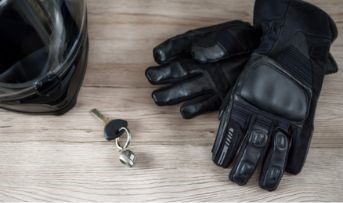General Insurance Blogs, Articles & Updates by - Magma HDI
Have us call you
- RENEW YOUR POLICY
- BUY NEW POLICY

What is the no-objection certificate for bikes, and how to apply for it
Suppose a bike owner plans to sell his bike or move with the bike to a new city. In this case, a NOC, or no objection certificate, is required to avoid legal issues.
A letter known as a NOC, or No Objection Certificate, must be issued to sell your bike. Even if you are relocating to a new city, a NOC must be given to register your bike in the new location. The NOC is also required if a sold bike is to be registered in the name of the new owner.
How is NOC applied for a bike?
You must, under government regulation, receive a NOC from the RTO to validate your deregistration from that RTO. Without further ado, let's discuss the process for requesting a NOC certificate for a bike.
Here is a step-by-step instruction sheet for requesting a NOC for a bike when crossing state boundaries and intending to stay there for more than a year:
● To obtain a NOC, prepare an application and send it to the transport bureau in your area
● Fill up Forms 27 and 28 correctly, then submit them to the RTO
● If your vehicle was purchased using a loan or EMIs, get a NOC from the lender
You can expedite the procedure by obtaining NOC from the traffic department and your local police station in addition to following these steps.
You must submit an application letter explaining your relocation plans and supporting documentation to your financier or bank to get their no-objection certificate (NOC). These could be an appointment letter, a job transfer letter, housing documentation for the new location, etc.
What factors are to be considered while applying NOC for a bike?
For a hassle-free process, consider the following aspects before you apply for the NOC for your bike:
● Authenticate the copies of the insurance policy and registration document for the bike
● Verify that the road tax is fully paid
● Ensure all of your information is accurate, especially the information in the application, along with the updated address
● Submit all corroborating documentation
● Make sure you have the confirmation of payment for the NOC application cost received through the Vahan Citizen Services website
Documents required to get NOC for a bike.
The following list of documents must be sent to the RTO to obtain bike re-registration or transfer bike ownership:
● Motorcycle registration certificate
● Form 28
● Bike insurance copy
● Road tax receipt
● Certification for pollution control (PUC)
● Numbers for your bike's engine and chassis
● Signature recognition
The following documents are required if you want to obtain a NOC from the bank:
● The loan documents
● Bike registration document
● Other documents that the bank may request
The NOC is, therefore, a legally required document that must be obtained for various reasons when dealing with bikes. Along with the NOC, don't forget to buy bike insurance online to safeguard your valuable asset when you move to another state. Buying a robust insurance policy online will help you enjoy several features and financial benefits that can aid you in recovering from loss due to damages.
Click HERE to buy bike insurance online and get exciting benefits.
Disclaimer: The information provided above is for illustrative purposes only. To get more details, please refer to policy wordings and prospectus before purchasing a policy.

Beginners guide to learn jumping rope at home
Physical exercise is one of the basic requirements for a healthy and functional body. A few minutes of physical exercise, when combined with a balanced lifestyle, can give tremendous results to keep your body in the best shape.
It would be best if you also take a balanced diet to maintain all the nutrients and vitamins in your body. Also, try practising mindful activities like yoga and meditation regularly can be a good booster for your mental health. Physical exercises can range from walking, swimming, jogging, and cycling, to trekking and even rope jumping.
Jumping rope is one of the easiest and most convenient ways to lose extra calories and stay physically active. If you're a beginner at jumping rope, this article is just for you. We will cover all the essential points that should be kept in mind before you start jumping rope at home. It is a brisk and healthy exercise for your mind and body.
Let's look at the basic requirements for jumping rope at home without further ado.
1. Choose the best rope:
You must choose a comfortable, lengthy, and sturdy rope for your exercise. For beginners, a light weighted rope with comfortable foam grips is highly durable and flexible.
2. Pick a suitable surface:
If you want a comfortable surface for jumping rope, you should choose a mat or a smooth indoor surface. If it still does not work for you, please go outdoors and find hardwood floors if possible.
3. Start with basic jumps:
Start by learning to hold the rope properly. Do not grip the rope too tightly. Make sure you hold it loosely with your fingers instead of your palms. With a loose grip, the rope will turn quickly and steadily without any extra effort from your side. Make sure to hold the rope close to your body for a rhythmic spin.
4. Focus on movements:
After you have mastered your grip, you should focus on the movements of your body. You can start by placing the rope behind you. Turn it over your head and catch it under your feet. Make sure that you practise it until you've mastered it. Keep pushing yourself till you perfect the skill.
5. Keep on practising:
Although it may look complex, you should take the first step and do it. Be very gentle with yourself. Do it slowly as you get a grip on the process. Start with five jumps and increase the counts every day. Try to beat your record every day and reward yourself with positive affirmations.
Mistakes to avoid.
The things that you should avoid when you jump rope are:
● Do not jump too high:
It is one of the most frequently committed mistakes by beginners. If you think jumping too high will reduce more calories, you're wrong. On the contrary, it puts you at risk of developing a sprain. You do not have to take giant leaps, but you can jump just some inch off the ground.
● Not jumping upright:
It is always recommended to jump upright or in an erect position. Do not jump with a hunched back. If you hunch your shoulders, the jump will not be proper, and you can also develop a bad body posture. Later, you may also experience back pain.
These things should be considered before you commit to jumping rope at home. It would help if you were very careful when starting a new physical exercise. Make sure that your body is comfortable with the exercise. Regardless, opt for the best personal accident insurance policy in India to avoid problems later.
Click HERE to purchase the best personal accident insurance policy in India.
Disclaimer: The information provided above is for illustrative purposes only. To get more details, please refer to policy wordings and prospectus before purchasing a policy.

Look for these features in a cruiser motorcycle as a beginner
Riding a motorcycle offers an adrenaline thrill that no other commute mode can provide. Commonly associated with feelings of freedom and adventure, motorcyclists often experience euphoric joy while steering their ride. However, the biggest concern with riding bikes is the safety features that can protect the riders in an accident. Despite manufacturers constantly rolling out new features that enhance rider protection, one must use other modes to ensure safety, including two wheeler insurance India.
Among all the bike categories, the cruiser bikes market share in India is significantly increasing. These incredibly stylish bikes are equipped with cutting-edge technology like infotainment, navigation, and many other features.
Here are some standard features to expect when purchasing a cruiser motorcycle.
1. Seat height
The most challenging issue that beginners have with two-wheelers is maintaining balance. Sitting upright in a relaxed position is critical to stabilising the bike. If your balance falters, you can place your feet on the ground to regain control over the motorcycle. For this purpose, low seat height is essential for easy ground access.
2. Comfort-centric riding ergonomics
The rider’s posture is crucial to ensure proper balance and prevent accidents. Sports or commuter bikes allow room for tense posture that can harm the rider in the long run. Cruisers have a design that facilitates a relaxed sitting stance on an amply cushioned seat. This promotes good riding posture and makes for comfortable long-distance rides.
3. Sound engine
Cruisers are often considered to have low-power engines that offer inefficient acceleration. However, they are not far behind the power and capacity of commuter bikes. While you cannot expect the high speeds that sports bikes offer, cruisers provide adequate power for both short rides and long highway adventure trips.
4. Comfortable pegs
Most motorcycle designs leave riders with insufficient space to position their feet, resulting in uncomfortable long rides. The peg positioning in cruisers allows stretching of the legs compared to the normal riding posture in commuter bikes. You do not require additional highway footpegs to increase room for efficient leg positioning. Ensure you take a test ride on the bike before purchasing to get used to the positioning. Ideally, your midfoot should rest on the pegs. Your knees do not cross the peg, thereby preventing muscle strain.
5. Storage saddlebags
For frequent riders, it is inevitable to travel with baggage. Cruisers come with additional storage space in the form of saddlebags and extra luggage capacity in the rear. This greatly helps reduce distractions while riding. The bike’s build also allows greater room to attach other travel accessories, making for a great long-distance ride.
6. Chassis weight
Cruisers often have a heavy design that weighs them down, requiring riders to have adequate physical build to manage the bike's weight. This is a boon and bane. Positively, it slows down the vehicle and minimises the risk of accidents, but as a con, it requires additional effort to manoeuvre the bike single-handedly. However, this makes it among the safest bikes to ride. Supplementing it with two wheeler insurance India goes a long way in amping up the rider's protection.
Before purchasing a cruiser, ensure to go on a test ride to evaluate its weight and your ability to manage it.
Careful evaluation of a bike's mechanical features and safety provisions is necessary irrespective of its type. While beginners may find cruisers comfortable, safe, and suitable for long rides, one must always purchase two wheeler insurance India to stay protected against the allied financial costs of accidents.
Two wheeler insurance India is a mandatory requirement that ensures financial protection against accidents that every bike owner must prioritise.
Click HERE to buy two wheeler insurance India policy.
Disclaimer: The information provided above is for illustrative purposes only. To get more details, please refer to policy wordings and prospectus before purchasing a policy.

Best tips to do daily tasks with convenience after a fracture
A fracture brings pain and many inconveniences while performing your daily routine tasks. You have to start doing things differently and take help from others to finish your work. A fracture is different from a regular cold or fever, which is cured in just a few days. A normal fracture takes at least 20-25 days to heal, and more complex ones can take several months before you return to normal routine.
Hence, a fracture can be very troublesome if you do not handle it properly. Here are the best tips to do daily tasks conveniently after a fracture.
1. Simplify your daily tasks:
The first thing you should do after suffering from a fracture is to simplify your daily tasks. For example, cooking yourself may mean standing for long hours in the kitchen. It will put undue pressure on your broken bone and slow the healing process. Take help from other family members or your maid in cooking to ease the work. If you are the sole cook, you can start ordering more online for the first few days. You can also buy packed and frozen food and avoid cooking much for a few days.
Similarly, opt for a shower rather than using a bucket for taking a bath. You should use a non-slip mat in your bathroom to avoid slipping and hurting yourself again. You can use a bathing chair if it is comfortable for you. Buy a sponge with a long handle, so it becomes easy for you to scrub your feet and back.
2. Avoid driving:
Do not drive yourself, even if you can, as it will pressure your broken bone. Take a driver, go with a friend, or book a cab to your destination if it is important. Also, opt for “work from home” for a few days rather than going to your office.
3. Dressing-up:
Wear comfortable and loose clothes after a fracture so that it is convenient for you to dress up or change. You can get velcro stitched over the buttons of your shirt if you cannot open or close buttons with your fingers. Opt for elastic in your pants or jeans. Buy a shoehorn with a long handle so that you can wear your shoe without bending much. Also, do not wear heels or uncomfortable shoes to minimise the chances of falling over.
4. Declutter:
To make it convenient, you need to declutter your house and working area after a fracture. You can move furniture on the sides to get a wide walking area. This will help you move easily and also minimise the chances of accidents. Light up your house properly, so you do not trip over things in your way. Proper lighting is essential if you need to wake up at night and move around.
If possible, you can move to the ground floor for a few days to avoid climbing stairs. Do not sleep on a very low bed, as it can be uncomfortable for you to get into the bed. If your fracture takes a long time to heal, you can install handrails near your bed, bathroom, and stairs and hold them for added support.
A fracture is undoubtedly painful and causes a lot of inconvenience to you. It derails your daily life and makes you dependent upon others. Personal accident insurance is crucial for you in such situations. It will provide you with financial protection and security in case of injuries and partial or total disability arising due to accidents. Hence, go for the best personal accident insurance India and secure yourself and your dependents in case of any unfortunate event.
Click HERE to invest in the best personal accident insurance India.
Disclaimer: The information provided above is for illustrative purposes only. To get more details, please refer to policy wordings and prospectus before purchasing a policy.


